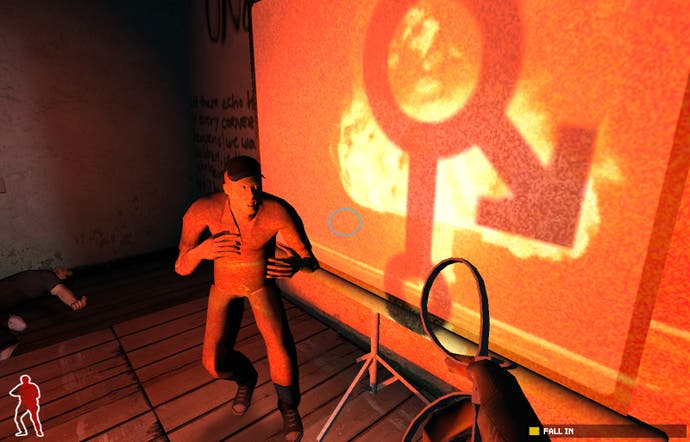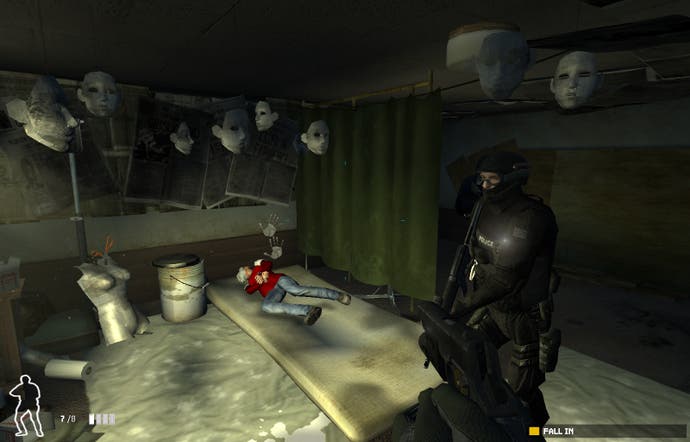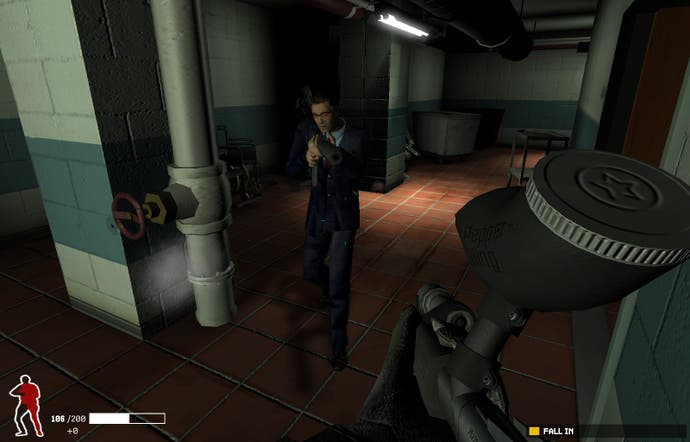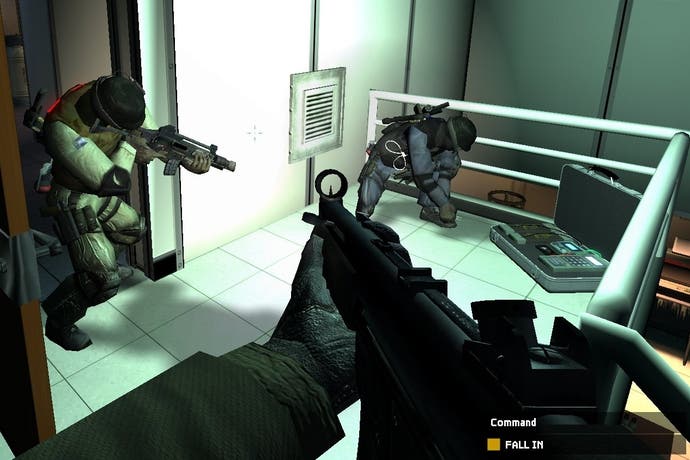SWAT 4 retrospective
It's a fair cop.
A dropped flashbang blinding my whole team. An innocent store clerk shot in the face at point blank range. A cult member bearing an Uzi casually opening a door onto a man performing a cautious zig-zag and hissing "Boss! You're in my spot!".
I'm rubbish at games, but it's games like SWAT 4 that let me revel in my inadequacy. Other shooters make me feel bad about the time I spend hiding behind the furniture with my finger hovering over the quicksave button, but Irrational's entry in the squad shooter canon still makes it feel good to whistle a tazer charge past a hoodlum's elbow and straight into the face of a crouched shopkeeper. I am become Keystone Kops. Hilarity conquers all.
Tactical shooters are somewhat out of vogue these days. We've become a little too comfortable with AI companions who shimmy up to doors and wrench them open without waiting for the signal. SWAT 4, however, was a brilliant example of the hard-edged squad commands that this console generation's lean to the mainstream has gone to great pains to rub away.

I didn't stand in SWAT 4's doorway with a breaching charge because of a deep affinity with tactical manshoot. I played it because it was an Irrational game; one of a brace of titles that Levine's men took on for Sierra to re-energise dormant franchises. As things turned out, they were the games that would pay the bills in the run up to bigger, brighter (and deeper) things. Two rather dry game series, Tribes and SWAT, were taken in and given a narrative sparkle. I'd argue that the results were remarkable - even if they'd go on to pretty much sink without trace.
While Tribes: Vengeance was an over-stuffed multi-generational soap opera of princess sports stars and cyborg ninjas (essentially where Dynasty met Battlestar), the treatment SWAT received was much more granular. Every mission within the city of Fairview was entirely unconnected - with hostage situations in nightclubs, Chinese restaurants and cut-and-shut garages popping up in as random a fashion as the real-world emergency services would find them. Where the stories were told, beyond the 911 call and briefing, was in the exploration of these buildings and what they contained.
Sure, some missions were drier then others - but there are few gaming horrors quite as gnawing as making steady (read: haphazard) progress through a dank Fairview tenement while rain battered the windows, gradually learning more and more about the doomsday cult that had laced the building with explosives. When you reached the basement and discovered the shallow graves where they had recently buried their murdered children, before pausing to daub the walls with celebratory propaganda, it was genuinely chilling.
The hand of Levine wasn't directly on SWAT 4, but a direct line to BioShock's localised mise-en-scene storytelling is easily traced. That serial killer with all the masks in the second level too, eh? Brr... I pepper-sprayed his face good and proper.

In fact, I pepper-sprayed lots of people's faces good and proper in SWAT 4. Your final mission score is built from the squad members you still have walking, the innocents and suspects you've cuffed and the lethal force you've avoided when your team aren't in mortal danger. Shooting a perp that's in the process of surrendering will always make the unlock of the next mission that little bit harder. Given that each (frequent) mission reload randomises the placement of bad guys and innocents each and every time, there's always the possibility of stray bullets connecting with the heads of the innocent.
This brutal off-screen coroner's report doesn't hamper your overall lust for violence though, because you can get away with as much non-lethal NPC bullying as your heart desires. Whether you're faced by hostages, criminals or passing old ladies, you can scream 'Get down on the ground!', pelt faces with beanbags, repeatedly tazer, force-feed pepper spray and of course bark orders at your friends to do the same. If a passing CofE vicar were to wander into my recent SWAT 4 playthrough, he'd be excused for confusing it with a scene from a Soho Gentlemen's Club basement.
Best of all, this charming slice of sociopathy extended to the multiplayer. Playing as a crim in VIP escort and managing to take the SWAT team's precious human cargo was nothing less than a joy - especially when you knew the poor sod you were brutally manhandling and comedically tazering in real life.

Getting a gang together in co-op who were just as ineffective as yourself would lead to brilliantly bungled hostage rescues . There was one magical moment, back in the days of LAN gaming in the dear departed PC Zone offices, when our two teams were stacked up on two doors at either end of a criminal-infested basement. The order was given, and everyone piled in guns blazing - shooting ourselves dead so quickly that the enemy AI didn't even have time to react.
It can't be denied that SWAT 4 was a rough diamond. There aren't many gaming pains that dig as deep as having to laboriously backtrack through a rock club with an encumbering (and near fatal) chest wound to try to spot enemy weapons left lying in dusty corners. Likewise, not every mission hits the dank and disturbing heights of the serial killer's Fairfax Residence, or the creepy glow-in-the dark stars amidst the recently turned soil of the Taronne Tenement.
Even when you're in the faintly dull Red Library Offices or the Department of Agriculture in the (entirely decent) Stetchkov Syndicate expansion, however, there's always a pleasant degree of chaos and inanity to be uncovered by an optiwand neatly slotted beneath a nearby door.
If SWAT 4 taught us one thing, it's that there's always hilarity at the end of a tazer. There's no greater guffaw than that attributed to a helpless spasming body and 50,000 volts of pure justice. None at all.

